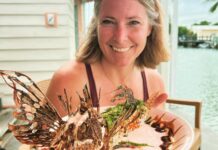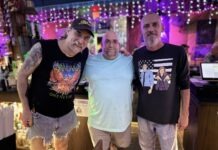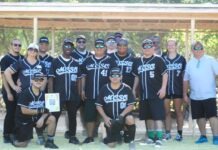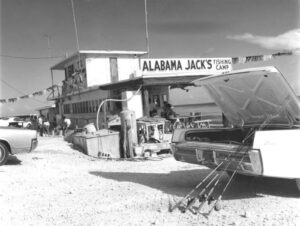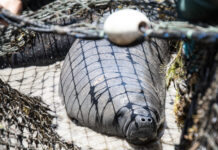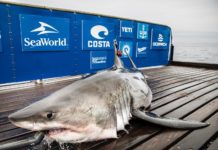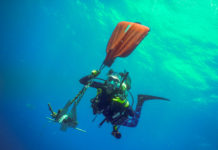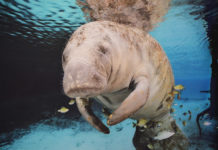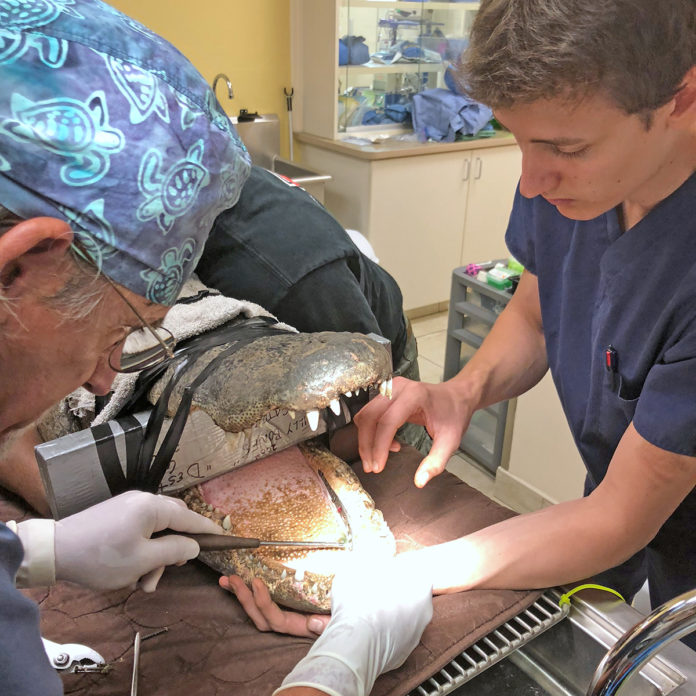
It’s a rare morning that a 9-foot alligator is wheeled into a veterinary clinic for surgery. But then Marathon Veterinary Hospital isn’t an average clinic, and this patient is a familiar face. Dr. Doug Mader and his round-the-clock medical team are the Keys destination for all things furry, feathered, and in the case of the gator, many-toothed.
“Now his name’s Split Jaw. It originally was Destroyer,” said Mader. This reptile, who calls Everglades Outpost home, has returned for a third procedure on his broken jaw. The source of his recurring injuries is fighting.
“Two of them bit each other in the face. He bit a bigger one, and the bigger one rolled and split his lower jaw. So he came in, and I fixed the lower jaw. Then, about a year later he got in another fight, and that alligator broke the side of his jaw.” Split Jaw has visible wiring in the bottom front of his jaw and a long titanium plate running along the lower left side of his mouth.
“He’s in the penalty box,” said Mader, “because he is a trouble maker.”
The three-person volunteer team from Everglades Outpost, a wildlife sanctuary in Florida City, delivered the gator Thursday morning, along with two Japanese snow macaques and a sick possum. They take methodical care with the alligator, unzipping him from his travel “body bag,” and they speak to him gently as Mader delivers a shot of the sedative Telazol.
“We aren’t just responsible for his safety, but the safety of everyone in this room,” said Martha Frassica-Rivera, a veteran volunteer for the Outpost assisting in the transport. “He’s such a smart gator, and that’s what makes him dangerous,” she said.
This kind of relationship with a dangerous alligator is moving, especially in a summer that alligator attacks have dominated regional news. According to the Florida Fish and Wildlife Conservation Commission, attacks have spiked this year at 16 — the highest since 2001. The first week in July, a diver’s arm was badly mauled by an alligator in the Charlotte County Golf Course Lake. A couple of days later, a 71 –year-old woman was airlifted out of Fort Meyers after being bitten, and a week after that, a 10-year-old boy was bitten while on vacation in Acadia.
The most horrifying and heartbreaking of the summer was the story of Shizuka Matsuki, a woman walking her dogs in Davie, Florida. Matsuki was dragged into a waterway by a 12-foot alligator, while her dogs barked nearby. Emergency responders recovered Matsuki alive, but she died shortly after.
As Florida becomes more populated — not to mention polluted — human developments disturb the habitats of some 1.25 million gators that have called the land home for nearly 40 million years. In most cases of human-alligator encounters, the alligator ends up dead. This runs counter to the attitude of the Everglades Outpost, a non-profit that offers sanctuary to animals from “illegal, traumatic, or abusive” situations. Ideally, they rehabilitate and release them into the wild, but in cases like this gator, they will keep the animal on the preserve because of its dangerous nature.
Mader has been seeing exotic patients from the Outpost for 20 years. “Not many vets are trained for alligators,” Mader said. He is triple board-certified. In addition to feline and canine training, he’s trained in primates and zoo animal medicine, and, of course, reptiles. Thursday is his “exotic day.” Mader works with “a half dozen alligator facilities in the Homestead area and on the Tamiami Trail with all the tourist mom and pop shops. They all have an alligator out by their airboat. And I take care of those alligators.”
Once Split Jaw is under the spell of the Telazol, Mader and the Outpost team wheel him into the surgical area. “We are going to take an X-ray of the jaw to be sure the bone has healed, and if it has, we are going to pull out the plate.” After X-rays, Mader said, “The bone looks strong.” He will remove the plate. As the alligator stretches out on the operating table, the team holds him secure. When Mader starts with a drill on the screws in his jaw, the gator bucks and twists, the team struggling to hold him steady.
“He’s tensing!” They brace for the next movement.
“They are really sensitive, and I think the vibration is making him wiggle.” Mader abandons the drill and decides to loosen the screws by hand, working quickly in the alligator’s massive jaws. The alligator is sedated, but he’s not entirely out.
“Alligators are one of the most challenging animals to anesthetize,” Mader explained, “because they have a hole in their heart, and they can shunt blood to their lungs. So using a gas anesthetic on an animal that doesn’t use his lungs is a real challenge. And when you do get them under anesthesia, then they can sleep for a day. That’s why we are doing sedation-only today.”
Mader successfully completes the removal of the plate. The jaw has healed properly, and Split Jaw can go home. “That’s $750 in screws and a $775 plate,” Mader said. “You’ve got to give these guys credit for taking care of their animals.”
Split Jaw isn’t the only patient on the roster. Dr. Mader gives annual exams to the two snow macaques and pronounces both healthy. The busy facility is state of the art: video webcams for the kennels, an area for exotics, a metabolism cage to raise or lower the temperature of animals slowly, a full surgery suite, X-ray room, a separate space for endoscopies, and even a Chinese medicine and “family room,” designed by Mader’s wife, Dr. Deithelm. The hospital is built to sustain a Category 5 hurricane and was open the Friday after Irma.
The Outpost team packs up Split Jaw for his road trip home to Florida City. While not many vets will see exotics, few if any have training comparable to Mader’s. It’s no wonder that he is sought after for exotics across South Florida. Mader laughs: “Exotics are like the redheaded stepchild in veterinary medicine, but we do them here. And we always do them right.”





